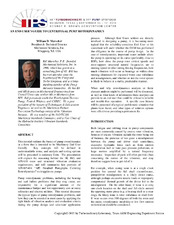| dc.description.abstract | This tutorial outlines the basics of pump rotordynamics in a form that is intended to be Machinery End User friendly. Key concepts will be defined in understandable terms, and analysis and testing options will be presented in summary form. The presentation will explain the reasoning behind the HI, ISO, and API-610 rotor and structural vibration evaluation requirements, and will summarize key portions of API-RP-684 “API Standard Paragraphs Covering Rotordynamics” as it applies to pumps. Pump rotordynamic problems, including the bearing and seal failure problems that they may cause, are responsible for a significant amount of the maintenance budget and lost-opportunity cost at many refineries and electric utilities. This tutorial discusses the typical types of pump rotordynamic problems, and how they can be avoided in most cases by applying the right kinds of vibration analysis and evaluation criteria during the pump design and selection/ application process. Although End Users seldom are directly involved in designing a pump, it is becoming more typical that the reliability-conscious End User or his consultant will audit whether the OEM has performed due diligence in the course of pump design. In the case of rotordynamics, important issues include where the pump is operating on its curve (preferably close to BEP), how close the pump rotor critical speeds and rotor-support structural natural frequencies are to running speed or other strong forcing frequencies, how much vibration will occur at bearings or within close running clearances for expected worst case imbalance and misalignment, and whether or not the rotor system is likely to behave in a stable, predictable manner. When and why rotordynamics analysis or finite element analysis might be performed will be discussed, as well as what kinds of information these analyses can provide to an end user that could be critical to reliable and trouble-free operation. A specific case history will be presented of a typical problematic situation that plants have faced, and what types of solution options were effective at providing a permanent fix. | en |


